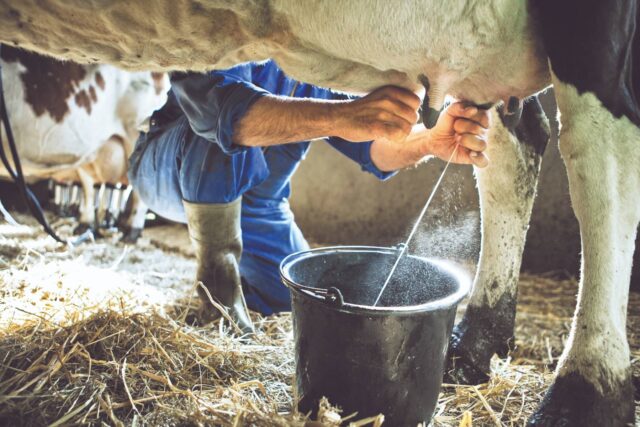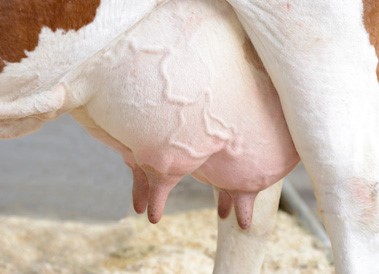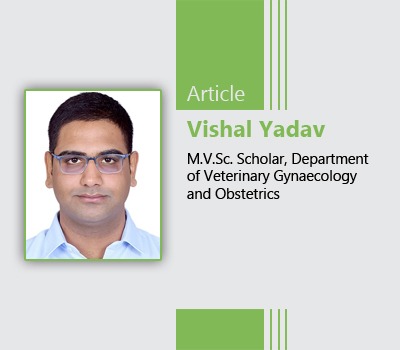
The golden rule of clean milk production is,“prevention is better than cure”
A contaminated milk contains dust, dirt, foreign material, off flavor, and a high microbial count. Sources of contamination include macro and micro environment around milk like cows body, udder tissue, surrounding soil and air, utensils, fomites, milker, and its belongings, dung, rocking tail etc. Contaminated milk may lead to severe health problems.
Sources of Contamination
a) Udder
Unhygienic conditions of milking farms, and bedding material and belongings of animals may lead to microbial growth. As the teat canal remains open for a period of time after milking, these microbes get an opportunity to enter, leading to udder infection such as mastitis which makes the milk unconsumable. Always discard the few strips of foremilk as it contain high bacterial count and dead epithelial cells. Always perform the complete milking as incomplete milking may lead to udder infection.
b) Animal´s Body
Microbes present on the animal´s body may contaminate milk at the time of milking. Maintaining clean skin, flank washing, and cleaning udder with a clean damp cloth before milk decreases the chances of contamination.
c) Milking Farms
Milking farms having good cross ventilation and clean flooring avoid contamination of milk.
d) External Parasites
External parasites like mosquitoes, flies, lice etc may contaminate the milk, so, care must be taken to avoid these parasites by spraying antiparasiticides. Eliminate breeding areas of these parasites like stagnant water, hot and humid atmosphere, etc.
e) Milker
Milker comes in direct contact of milk and hence responsible for primarily contaminating the milk. Dirty hands, belongings and clothing of the milker may act as the source of contamination. Several microbial diseases may transmit from the milker to the milk. Persons having sign and symptoms of diseases like dysentery, tuberculosis, diphtheria, and typhoid must be avoided to perform milking. Bad habits like drinking, and smoking must be avoided.
f) Utensils
The containers or equipment in which the milk is handled, processed, stored or transported are called utensils. Clean, dirt and dust-free, sanitized or disinfected, smooth copper free and dry utensils should be preferred in milking.
g) Methods of Milking
Milking with wet hands or using a bend thumb against teats (called knuckling) leads to contamination of milk. In rural areas, milkers moisten their fingers with milk, water or saliva, to perform milking. This must be avoided. Wet hand milking leads to harsh and dry chokes, cracks and sores on teats predisposing it to infection and finally leading to milk contamination. Knuckling causes damage to the teat tissue which leads to udder infection. So always practice dry hand milking with full hand milking method (grasping teat in palm by encircling between thumb and four palm fingers).
Steps in Clean Milk Production
- Always wash the animal before milking,as it minimizes microbial entry.
- Promote dry udder practices because moist udder lead to milk contamination by dirty drops falling into the milk. Hence, udder should be washed, clean and sanitized, and finally should be wiped out using dry cloth.
- Proper washing, cleaning and sanitization of milker´s hand must be done followed by wiping with clean dry cloth to avoid wet hand milking.
- Proper and complete hygiene of milker is necessary like short hairs, trimmed nails and proper bath.
- Milker should be free from all diseases and must not have any disease which is a potential source of milk contamination like dyssentry, tuberculosis, diphtheria, typhoid.
- Never feed dusty feeds to animals during milking and reduce animal movements during milking by providing the concentrated feed.
- Proper restraining of animal is necessary during milking as it may lead to milk. contamination, for example by using milker´s knot on hind legs above hock joint and tying of tail.
- Milking farms should be properly washed, cleaned and well ventilated and also free from flies and other parasites.
- Use clean, sanitized, smooth and copper free utensils for milking.
- To avoid undesirable smell and taste in milk, feed flavour producing feeds after milking.
- Discard first few drops of milk and use small mouthed container covered with muslin cloth to collect milk.
- After milking cover the container properly to avoid environmental contamination.
To increase shelf life and keeping quality of milk, properly store milk in cool and dry place and may refrigerate or freeze if long time storage is provided.

Milk Hygiene
In case udder is healthy and normal, the milk is sterile. Most of the contamination occurs during and after milking. Use mastitis control routines at each milking to reduce the proportion of infected cows and clinical mastitis cases. With better management and care, milk contamination can be avoided. Perform dry udder and clean milking practices. As milk is a good media for microbes, proper storage and handling is very necessary.

Udder Health
Udder should be maintained clean as it avoids source contamination before milking. The greatest economic loss to dairy industry is by mastitis. Management of cows should be like that their udders and teats are clean and milking is to be done in such a way that minimizes microbial contamination. Keep udder covered with a cloth so that dust and dirt especially when animal lies down is restricted and always perform teat dipping after milking and not allow the animal free to lie down for few minutes after milking because pores of teat canal remains open after milking for sometime which leads to direct microbial entry into the udder.

Points to be Noted
- Never drink or promote consumption of unpasteurized or unboiled milk as it may lead to life threatening situations.
- Perform milk and udder examination time to time by consulting a veterinary doctor.
Conclusion
As milk is an important diet source in Indian food habits and it is also a perishable product, and if consumed or stored or handled unhygenically it may lead to development of diseases which may be life threatening or zoonotic (diseases which transmit from animals to humans like brucellosis) in natrure. So, focus should be given on clean milk production, milk hygiene and udder health so that economic loss and loss of healthy life can be avoided.
Also, read | Biosecurity as an Economic Security
Author:

Vishal Yadav1*
1M.V.Sc. Scholar, Department of Veterinary Gynaecology and Obstetrics
College of Veterinary and Animal Science, Bikaner
Rajasthan University of Veterinary and Animal Sciences, Bikaner (RAJUVAS – Bikaner), Rajasthan – 334001, India*Corresponding author: Vishal Yadav (M.V.Sc. Scholar), email: vishalyadav1131997@gmail.com

















